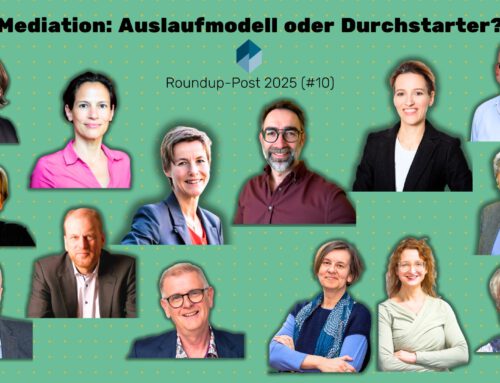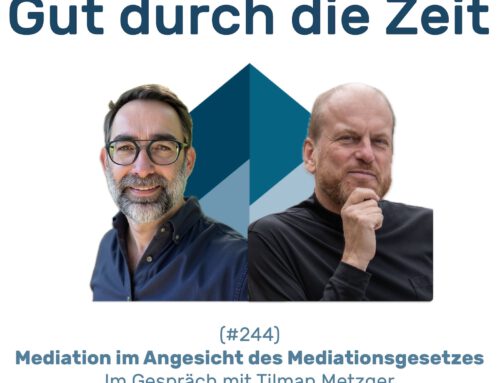Essay: Organisational ambidexterity and organisational mediation
in: Conflict Dynamics 03/2021, p. 211 – 218
Dr Sascha Weigel
Extract…
„…Critical appraisal
Ambidexterity research offers an understanding of the pressure to change and a linearly derived, unsurprising solution approach for organisations and companies.
Just do both if you want to make it work!
In order to understand the current economic situation of companies, the need for change due to the well-known changes in the environment is becoming increasingly important. globalisation processes and their reversal, digitalisation trends and the recent virus pandemic. None of these phenomena required explicit "ambidexterity research". Viewed soberly, the approach appears neither novel nor profound, although the analysis itself is impressively simple and accurate.
The idea of keeping an eye on the future in economic activity and its organisation is by no means something that has only recently emerged with ambidexterity research, but rather represents the core of the capitalist economy. Turning existing money into capital, investing in organisational structures and processes today in order to reap more tomorrow has existed and been virulent since the great transformation of human economic activity in the early modern era. No longer experiencing economic activity as a continuous cycle of repetition, which can of course be optimised, but rather using resources today to produce added value tomorrow or, in short, realising social economic activity no longer as a zero-sum game, but as a value-added game. To use a biological analogy to describe the strategic necessity of focusing organisational and personal attention on two different focal points at the same time seems a little limping in view of this fundamental change. At best. On the one hand, the comparison is not accurate, because ambidexterity is not simultaneity. Moreover, biological ambidexterity is something special precisely because both limbs, i.e. materially different limbs, are supposed to perform the same thing with the same quality, whereas this is not the point for organisations. Instead, different things should be performed simultaneously. And these different modes are carried out on the one hand – by different people, teams, departments and areas at the same time – so that the idea of ambidexterity simply appears as a fancy description of the division of labour. Or, in the case of "sequential ambidexterity" in particular, both modes should or can be switched one after the other, which ultimately counteracts the core analysis of ambidexterity research, namely simultaneity.
Organisational ambidexterity and organisational conflict management
The ambidexterity demanded of an organisation is also reflected in the organisation's challenge to deal constructively with its own conflict potential. The changed understanding of conflict, which means that escalations do not per se affect the organisational machinery (danger of exploitation mode), but that conflict potential can also reveal organisational potential for change and innovation that "should" be understood and used (invitation to explore mode), challenges the ambidextrous handling of this conflict potential.
This requires procedures that can take this area of tension into account and offer appropriate approaches. This means that procedures are needed that not only see the conflict as a flaw and can eliminate it, such as the right-orientated procedure, which is aimed at reconciliation. Instead, procedures are needed that also define transformation and organisational development as objectives and not just accept them as side effects. This is where mediation and other consensual dispute resolution methods come in.
Change in the understanding of conflict
In the context of work and business, it is essential for the change in the understanding of conflict that a conflictual working relationship does not immediately represent a flaw, hindering production, endangering products or being declared as an organisational and management flaw, but that the perspectives, interpretation and definition schemes revealed by the conflict are taken up organisationally and used in accordance with the strategic orientation in order to create constructive approaches to understanding and solutions with them.
Insofar as organisations adhere to the (self-)image that they want to resemble a well-oiled machine, they activate the exploitation mode and see conflict escalations as a threat to efficiency and "frictionlessness". Only with an inquisitive eye for the unknown and overlooked, coupled with a willingness to throw the status quo overboard, are exploratory activities unleashed and conflict interpreted as a constructive challenge.
Conflicts are – even if possibly only in an idealised management mode driven by innovation needs, no longer exclusively the "sand in the organisational gears" or the "salt in the interpersonal soup", but possibly the "stone of the impetus" for the hoped-for and necessary innovation.
Change in conflict management
…“
Complete bibliography for the essay:
- Balling, R. (2014): Dilemma situations in (organisational) mediation processes, in: Theorie und Praxis der Transaktionsanalyse in der Mediation. Handbook, edited by Sascha Weigel, pp. 469 – 481, Baden Baden 2014.
- Bannik, F. (2009): The practice of solution-focussed mediation. Concepts, methods and exercises for mediators and managers, Stuttgart 2009.
- Beckert, J. (2018): Imagined futures. Fictional Expectations and the Dynamics of Capitalism, English original 2016, Frankfurt am Main 2018.
- Bischoff, F. (2014): Über den Einfluss des Strategie eines Unternehmens auf die Konfliktdynamik in Wirtschaftsmediationen, in: Konfliktmanagement in der Wirtschaft, Ansätze, Modelle, Systeme. Edited by Gläßer, U. / Kirchhoff, L. / Wendeburg, F., Konfliktmanagement in der Wirtschaft. Baden Baden 2014, p. 439 – 456.
- Dum, Thorsten / Sierau, Axel: People Analytics. What organisations can learn from professional football, in: OrganisationsEntwicklung, 4/2020, p. 75 – 79.
- Duncan, R.B. (1976): The Ambidextrous organisation: Designing Dual Structures, for Innovation, in R. Kilman & L. Pondy (eds.) The Management of Organizational Design. New York: North Holland: 167-188.
- Harari, Y. N. (2014): Sapiens. A Brief History of Humankind. London 2014.
- Harari, Y. N. (2018): 21 Lessons for the 21st Century, London 2018.
- Jansen, J. (2005): Ambidextrous Organisations. A Multiple-Level Study of Absorptive Capacity, Exploratory and Exploitative Innovation and Performance, Erasmus Research Institute of Management (ERIM) 2005.
- Maturana, H.R. / Varela, F. J.: The tree of cognition. How we create the world through our perception – the biological roots of human cognition, Bern-Munich-Vienna 1987.
- Morgan, Gareth (2002): Images of Organisation, original 1986, 3rd edition, Berlin 2002.
- Müller, Christiane / Schmidt, Alexander: Ambidextrous?! The vital task of Leadership in the field of tension between existing and future business, in: Konfliktdynamik 1/2020, 31 – 37.
- Luhmann, Niklas: Social Systems. Grundriß einer allgemeinen Theorie, Frankfurt am Main 1984.
- O'Reilly, Charles A and Tushman, Michael L. (HBR 2004): The ambidextrous organisation, Harvard Business Review 2004, no. 4, Vol. 82, p.74-81;
- Plumpe, W. (2019): The cold heart. Capitalism – The story of an ongoing revolution, Berlin 2019.
- Pinker, St (2013): Violence. A new history of humanity, original 2011, Frankfurt am Main 2013.
- Pinker, St. (2018): Enlightenment now! The Case for Reason, Science, Humanism and Progress, New York 2018.
- Rieforth, J.: Process design for changes in organisations, KD 2012, 328 ff.
- Sapolsky, R. (2017): Violence and compassion. The biology of human behaviour, Munich 2017.
- Schumacher, Th. / Wimmer, R.: Shaping inconsistency. On the management of core and innovation business in the ambidextrous organisation, in: ZOE 4/2020, 10-15.
- Tushman, M. L. / O'Reilly, Ch. A. (1996): Ambidextrous Organisations - Managing Evolutionary and Revolutionary Change. California Management Review, 1996, no. 38, p. 8-30.
- Tushman, M.: Ambidexterity yesterday and today, Interview in: OrganisationsEntwicklung, 4/2020, 4-9.
- Weibler, J.: Ambidextrous leadership, in: Changement!, 2018, 1, 22-23.
- Weigel, S.: Transformative mediation and transactional analysis, in: Konfliktdynamik, 1/2017, pp. 34-45.
- Weigel, S.: Strategic mediation. Part 1 – Plea for an overdue change of perspective, in: Spektrum der Mediation, 70/2017, pp. 18-22.
- Weigel, S.: Organisational mediation in vukaesken Umwelten. Part 1 – For strategy- and future-oriented conflict management, in: perspektive mediation, 2/2019, p. 89 – 95.







Leave A Comment